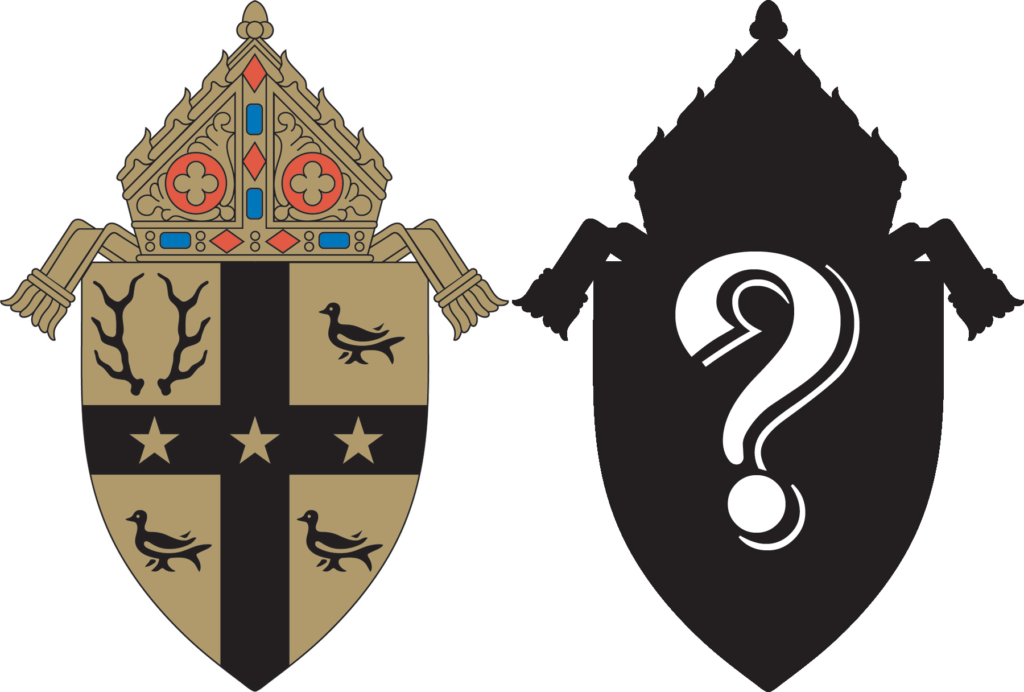 Coinciding with the release of Archbishop Vigneron’s pastoral letter, the Archdiocese of Detroit is expected to release a redesign of its longstanding coat of arms — first created in 1937 — to visually represent some of the “major turning points” in the life of the local Church, officials say. (Michigan Catholic illustration)
Coinciding with the release of Archbishop Vigneron’s pastoral letter, the Archdiocese of Detroit is expected to release a redesign of its longstanding coat of arms — first created in 1937 — to visually represent some of the “major turning points” in the life of the local Church, officials say. (Michigan Catholic illustration)New coat of arms to accompany new direction as archbishop prepares to release post-synod plans
DETROIT — As the culture, mission and identity of the Archdiocese of Detroit continues to undergo a major transformation following Synod 16, the longstanding look of the archdiocesan seal is also expected to be refreshed.
Coinciding with the expected release of Archbishop Allen H. Vigneron’s pastoral letter at the June 3 Pentecost Vigil, the archdiocese will unveil a new coat of arms to reflect the boldness and creative energy of “joyful, missionary discipleship,” said Msgr. Robert McClory, moderator of the curia for the archdiocese. [UPDATE: See the new coat of arms here]
“Coats of arms are typically changed only if there’s some major event,” Msgr. McClory told The Michigan Catholic prior to the release of the new seal. “The circumstances now are such that upon prayer and reflection the archbishop was presented with and reviewed whether some of the significant, major turning points in the life of our archdiocese would call for some new visual imagery with the new evangelization and a new coat of arms.”
Besides Synod 16, the naming of St. Anne as the patroness of Detroit by Pope Benedict XVI in 2011 and the emergence of Venerable Solanus Casey as a prominent intercessor for the city were also significant milestones for the local Church in recent years, Msgr. McClory said.
“Archbishop Vigneron, a man who is very respectful of history and tradition, has seen this most recent synod as being a true marker in the life of our diocese,” Msgr. McClory said. “If we are launching into the new evangelization in this distinctive way, our visual identity should respond to that. I think any one of those three things would have been sufficient, but the fact that we have three all at one time makes it a very appropriate time for us to revise the coat of arms.”
Msgr. McClory admitted he was first taken aback at the idea, but became open to the possibilities after seeing the archbishop’s enthusiasm for the project.
“Some dioceses would more frequently revise their coats of arms, but it’s not a common undertaking,” Msgr. McClory said. “This is a bold act on the part of the archbishop to say, ‘It’s time for us to have a new coat of arms’ and to be supportive of engaging this.”
The new coat of arms will see its official unveiling with the pastoral letter, which can be downloaded and read on a special webpage, unleashthegospel.org, when it is released June 3.
The updated crest will replace the current gold-and-black seal, which dates back to 1937, when the Diocese of Detroit was elevated to the status of an archdiocese.
“Historically, a coat of arms is an ancient tradition that would depict literally the shield that would represent you, your flock, your tribe, and those who you were guarding,” Msgr. McClory said. “The craft of heraldry then came forth in which you would take distinctive elements that would represent the family history, a community, a church, a diocese, and embed them on a coat of arms.”
The current seal, whose heraldry and symbols reflect the 1701 founding and rich cultural history of Detroit and its surrounding region, will be updated to reflect more of the recent history and culture of the Catholic Church in southeast Michigan, as well as the spirit of evangelization to which the Church is called, Msgr. McClory said.
The current archdiocesan crest is in the shape of a shield to represent one of the first Catholic martyrs of the New World, St. Isaac Jogues, a French Jesuit missionary who was tortured and killed by Native Americans while on mission in modern-day upstate New York the 1640s. As one of the first settlements in the American Midwest — and one of the first in North America founded by Catholics — Detroit’s history is closely tied with the French Catholic settlers and missionaries who followed in St. Isaac’s footsteps.
Incorporated into the current seal are symbols of Michigan’s rich natural beauty, with a pair of antlers in the upper left denoting the state’s abundance of whitetail deer, and the other three sections containing a martlet, a bird commonly depicted in heraldry. The martlet, which has feathers instead of feet, making it unable to land, is symbolic of the “never-ending quest for knowledge,” signifying the Church’s eternal desire to know Christ, but also a representation of Antoine de la Mothe Cadillac, a French explorer who founded Fort Ponchartain and Ste. Anne Church on the banks of the Detroit River in 1701.
The coat of arms is divided by a solid black cross with three stars, representing the Holy Trinity as well as the stars of the flag of the United States of America. Atop the crest is a jeweled miter representing the archbishop.
“One of the things we learned about the prior coat of arms, which had its time and its place, is that it actually had more roots in secular historical traditions relative to Michigan and Detroit,” Msgr. McClory said. “I think the new coat of arms is imbued with much more clearly religious and faith-based iconography."










